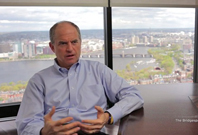 Josh Bekenstein is part of the new wave of philanthropists who aren't waiting to get seriously involved in giving. He, along with his wife, Anita, have a goal “to see if we can give it all away while we’re alive, and die broke.” He has chosen this path while simultaneously balancing a demanding full-time job as managing director of the financial firm Bain Capital and as the father of five. He has also chosen to forgo the help of a foundation or staff. So giving all the money away—and giving all the money away well—requires a thoughtful and strategic approach. “If you want to do philanthropy and you have no time,” he says, “you have to do it in an incredibly leveraged way.”
Josh Bekenstein is part of the new wave of philanthropists who aren't waiting to get seriously involved in giving. He, along with his wife, Anita, have a goal “to see if we can give it all away while we’re alive, and die broke.” He has chosen this path while simultaneously balancing a demanding full-time job as managing director of the financial firm Bain Capital and as the father of five. He has also chosen to forgo the help of a foundation or staff. So giving all the money away—and giving all the money away well—requires a thoughtful and strategic approach. “If you want to do philanthropy and you have no time,” he says, “you have to do it in an incredibly leveraged way.”
Taking a portfolio approach
Part of this strategy includes his and Anita’s “portfolio” approach: They have divided their philanthropy into three key interest areas—higher education, medical research, and poverty. For educational institutions and medical research, he concentrates on donating funds to educational institutions he and Anita have attended and to trusted Boston medical facilities. This leaves him free to focus his more involved giving on eradicating poverty—where he feels most needed and able to make a difference with his personal involvement and time.A two-way street: Josh Bekenstein is not “doing a favor” by donating to the organizations he support.
More From the Blog
Relying on friends for due diligence
Bekenstein’s strategic approach to philanthropy also includes a reliance on the wisdom of friends and associates who have longtime ties to philanthropy and on the intermediary, New Profit, a venture philanthropy firm that focuses its portfolio investments on innovative nonprofit organizations with the potential to create significant, long-term impact on the social mobility of low-income Americans and of which he is the board chair. Bekenstein is interested in investing in great social entrepreneurs and their big ideas, but does not have the time to conduct research on these early-stage organizations or provide the non-financial support they need to thrive. So he turns to New Profit to conduct due diligence on high-potential social entrepreneurs and to resource them with capacity building services. In return, Bekenstein meets his end of the bargain by writing checks, chairing a capital campaign, demonstrating leadership on an issue by giving publicly, and finding new donors for an organization supported by New Profit.
Focusing on the donor-nonprofit partnership
A third key component of Bekenstein’s philanthropic strategy is his belief in the “mutuality of interest” between himself and the nonprofit organizations with which he works. He does not think that as a donor he is “doing a favor” for grantees. Instead, he says that philanthropy is a two-way street. Although a donor's support certainly helps grantees accomplish their goals, great organizations are vital to a donor’s ability to achieve his own philanthropic goals. "You’re doing yourself a disservice as a donor, and you’re making life harder on the organization if you think that...you are doing them a favor to give them money," he observes.You can learn more about Bekenstein and find a complete archive of his interviews for Conversations with Remarkable Givers on his page.
This post is part of our series focusing on Conversations with Remarkable Givers, our collection of one to three-minute video clips drawn from over 50 original and private interviews with philanthropists and foundation leaders. Our initial launch features more than 400 videos, which will evolve into a library of over 1,000 videos, as we take a deeper look at each donor over the coming months.
Previous Posts in this Series and Related Material
- Eli Broad's Three-Question Investing Test
- Creating an Effective Philanthropy Strategy for 2013: Five Ideas
- A Capstone Career in Philanthropy: Guiding Lessons
- Balancing Career and Philanthropy
- The New Breed of Philanthropist: Younger, Involved, and Innovative
- Starting Your Philanthropic Journey
- Finding Your Philanthropy Compass
- Nonprofit Due Diligence: Donor Decision Tool


